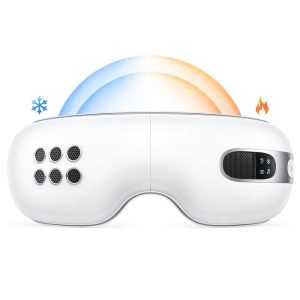Eye massagers custom order with logo print
Eye massager customization process, logo printing process, eye massager packaging design
Eye massager custom order with logo print
Customization process
The custom order process for an eye massager product would generally follow the steps below:
Inquiry
The customer reaches out to the seller to inquire about a custom eye massager product. This can be done via email, phone, or through an online form.
Consultation
Discuss the customer's needs and preferences in detail to understand the scope of the eye massager product. This may involve asking for specific features, materials, or any other requirements.
Proposal
Based on the consultation, the seller provides the customer with a proposal that outlines the scope of work, timelines, costs, and any other terms and conditions.
Agreement
Once the proposal is accepted by the customer, a formal agreement is signed between the seller and the customer.
Design and Development
The seller begins designing and developing the custom eye massager product according to the agreed-upon specifications.
Feedback and Revisions
The customer is given opportunities to provide feedback and request revisions to the design during the development process.
Prototype
Once the design is finalized and all revisions are completed, the seller produces a prototype of the eye massager product for the customer to review and approve.
Final Approval
Once the customer approves the prototype, the design is considered final.
Production
The seller produces the custom eye massager product, taking care to ensure that all specifications and quality standards are met.
Quality Assurance
The seller performs quality checks on the eye massager product to ensure it meets the customer's requirements and standards.
Packaging and Shipping
The completed eye massager product is packaged and shipped to the customer, either by shipping or through pickup arrangements.
Follow-up
The seller follows up with the customer after delivery to ensure satisfaction and address any concerns.
Logo printing process
The logo printing process can vary depending on the type of material being printed on and the type of printing method being used. However, the general steps involved in the logo print process are as follows:
Artwork Preparation
Material Selection
Printing Method
Color Selection
Printing
Drying or Curing
Finishing
Quality Control
Packaging and Shipping
Follow-up
About logo printing methods
There are several logo printing methods available, each with its own advantages and disadvantages. Some of the most common logo printing methods are:
Screen Printing: This method involves pressing ink through a stencil onto the material using a mesh screen. It is ideal for larger quantities of logo prints and can be used on a variety of materials, including fabric, plastic, and metal. However, it is not suitable for detailed designs or color gradients.
Digital Printing: This method uses a printer to directly apply the logo design onto the material. It is ideal for smaller quantities of logo prints and can be used on a variety of materials, including paper, fabric, and plastic. It allows for detailed designs and color gradients but may not be as durable as other printing methods.
Heat Transfer Printing: This method involves printing the logo onto transfer paper and then using heat to transfer the design onto the material. It is ideal for smaller quantities of logo prints and can be used on a variety of materials, including fabric and plastic. It allows for detailed designs and color gradients, but may not be as durable as other printing methods.
Embroidery: This method involves sewing the logo design onto the material using a needle and thread. It is ideal for fabric materials and allows for a three-dimensional effect. However, it is not suitable for detailed designs or color gradients.
Engraving: This method involves etching the logo design onto the material using a laser or rotary tool. It is ideal for metal and plastic materials and allows for a precise and durable logo. However, it is not suitable for colored logos and may not be cost-effective for larger quantities of logo prints.
The choice of logo printing method will depend on factors such as the material being printed on, the quantity of prints required, and the desired logo design.
Design and Customization Process for Packaging Color Boxes
- Define the packaging requirements: The first step is to define the requirements of the packaging. This includes determining the dimensions of the packaging box, the materials to be used, and the expected weight and durability of the packaging.
- Choose the box type and design: There are different types of boxes, including tuck top boxes, mailer boxes, and sleeve boxes. You need to choose the box type that best suits your packaging requirements. Once you have selected the box type, you can start designing the box. You can use software such as Adobe Illustrator or Photoshop to create the design.
- Choose the colors: The next step is to choose the colors that will be used on the box. You can use your company’s branding colors, or you can choose colors that complement the product inside the box. You can use a color wheel to select complementary or contrasting colors.
- Create a mockup: After designing the box and selecting the colors, it is time to create a mockup of the packaging. You can use a 3D packaging design software such as Packly or Esko to create a realistic representation of the box.
- Get feedback: Share the mockup with your team or stakeholders to get feedback. This feedback can help you make any necessary changes to the design.
- Print the packaging: Once you have finalized the design, you can print the packaging. You can use a printing service that specializes in packaging printing, such as Packlane or Printful.
- Customize the packaging: You can add additional customization to the packaging, such as embossing or debossing, foil stamping, or spot UV coating. These additional customizations can make the packaging more attractive and help it stand out on store shelves.
- Test the packaging: Finally, test the packaging to ensure it meets your requirements. You can test the packaging for durability, weight, and ease of use. You can also test the packaging’s ability to protect the product during shipping and handling.
L80 Heat and Cooling Eye Massager
Enhance your product line with our premium L80 Eye Massager featuring cutting-edge heat and cooling technology. Contact with us for customized OEM and ODM options.


Interested in “L80 Heat and Cooling Eye Massager”? Leave us a message via the form below!
Focus on Eye Massager for More Than 8 Years
We value your feedback, comments, and questions and will do our best to respond promptly. Don't hesitate to contact us - we look forward to hearing from you!
